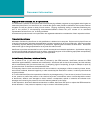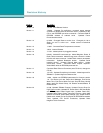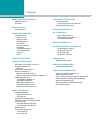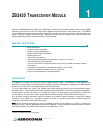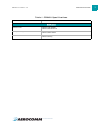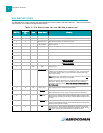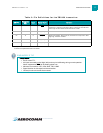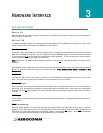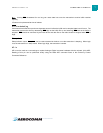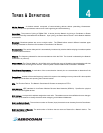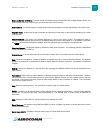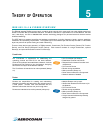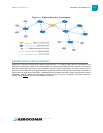
www.aerocomm.com
H ARDWARE INTERFACE
3
PIN DEFINITIONS
Generic I/O
Both GIn and GOn pins serve as generic input/output pins. Reading and writing of these pins can be performed on-
the-fly using CC Commands.
RXD and TXD
The ZB2430 accepts 3.3 VDC TTL level asynchronous serial data from the OEM Host via the RXD pin. Data is sent
from the transceiver, at 3.3V levels, to the OEM Host via the TXD pin.
Test/Sleep Int.
Test Mode - When pulled logic Low before applying power or resetting, the transceiver's serial interface is forced to
9600, 8-N-1 (8 data bits, No parity, 1 stop bit): regardless of actual EEPROM setting. The interface timeout is also set
to 3 ms and the RF packet size is set to the default size of 0x54 (84 bytes). To exit, the transceiver must be reset or
power-cycled with Test
pin logic High or disconnected.
Note: Because this pin disables some modes of operation, it should not
be permanently pulled Low during normal
operation.
Sleep Mode Interrupt - When logic Low, forces End Device to wake up from sleep mode. When logic High, allows End
Device to sleep and wake-up according to specified poll rate. Sleep Mode interrupt function available on End
Devices only.
UP_Reset
UP_Reset provides a direct connection to the reset pin on the ZB2430 microprocessor and is used to force a soft
reset. For a valid reset, reset must be asserted Low for an absolute minimum of 250 ns.
Command/Data
When logic High, the transceiver interprets incoming serial data as transmit data to be sent to other transceivers.
When logic Low, the transceiver interprets incoming serial data as command data. When logic Low, data packets
from the radio will not be transmitted over the RF interface however incoming packets from other radios will still be
received.
In Range
The In Range pin will be driven low when the radio is associated with a network. In Range will always be driven low on
a Coordinator.
RTS Handshaking*
With RTS mode disabled, the transceiver will send any received data to the OEM Host as soon as it is received.
However, some OEM Hosts are not able to accept data from the transceiver all of the time. With RTS enabled, the
OEM Host can prevent the transceiver from sending it data by de-asserting RTS
(High). Once RTS is re-asserted
(Low), the transceiver will send packets to the OEM Host as they are received.



